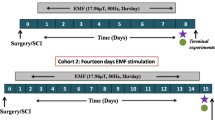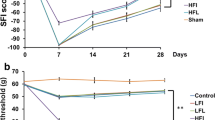Summary
The effect of magnetic stimulation (MS) on sciatic nerve injury was observed. After sciatic nerve was crushed in 40 Sprague Dawley (SD) rats, one randomly selected group (group D) was subjected, from the 4th day post-operatively to 3 min of continuous 70% of maximum output of MS daily for 8 weeks. The other group (group E) served as a control group. The nerve regeneration and motor function recovery were evaluated by walking track analysis (sciatic function index, SFI; toe spreading reflex, TSR), electrophysiological, histological and acetylcholineesterase histochemistry. The SFI in the group D was greater than in the group E with the difference being statistically significant (P<0.01). TSR reached its peak on the 4th day in the group D and on the 10th day in the group E respectively. The amplitude and velocity of MCAP and NCAP in the group D was greater than in the group E with the difference being statistically significant (P<0.01), while the latency and duration of MCAP and NCAP in the group D were less than in the group E with the difference being also statistically significant (P<0.01). Histological examination showed the mean axon count above the lesion for thick myelinated fibers (>6.5 μm) in the group D was greater than in the control group with the difference being statistically significant (P<0.01), while the mean axon count below the lesion for thick myelinated fibers was less than that in the group E with the difference being statistically significant (P<0.01). The mean axon count above the lesion for thin myelinated fibers (2–6.5 μm) in the group D was greater than that in the group E with the difference being statistically significant (P<0.05), while the mean axon count below the lesion for thin myelinated in the group D was greater than that in the group E with the difference being statistically significant (P<0.01). Acetylcholine esterase examination showed that the MS could significantly increase the number of the motor neurons. There was no significant difference in the number of the motor neurons between the treatment side and the normal side (P>0.05). It can be concluded that MS can enhance functional recovery and has a considerable effect in the treatment of the peripheral nerve injury.
Similar content being viewed by others
References
Dvorak J, Herdmann J, Vohanka S. Motor evoked potential by means of magnetic stimulation in disorders of the spine. Method Clin Neurophysio, 1992, 3: 45
Dellon A L, Mackinnon S E. Sciatic nerve regeneration in rat validity of walking track assessment in the presence of chronic contractures. Microsurgery, 1989, 10: 220
Brown C J, Makannon S E, Evans P Jet al. Self-evaluation of walking track measurement using a sciatic function index. Microsurgery, 1989, 10: 226
Hwere G M, Evans P J, Mackinnon S Eet al. Walking track analysis: A long term assessment of peripheral nerve recovery. Plastic Reconstr Surgery, 1992, 89: 251
Bain J R, Mackinnon S E, Hunter D A. Functional evaluation of complete sciatic, peroneal and posterior tibial nerve lesions in the rat. Plast Reconstr Surgery, 1989, 83: 129
Bratton B R, Kline D W G, Coleman Met al. Expmental interfascicular nerve grafting. J Neurosurg, 1979, 51 (3): 323
Grabb W C, Bement S L, Koppke G Het al. Comparison of methods of peripheral nerve suturing in monkeys. Plast Reconstr Surg, 1970, 46: 31
Ashur H, Vilner Y, Finsterbush Aet al. Extent of fiber regeneration after peripheral nerve repair: silicone splint vs suture, gap repair vs graft. Exp Neurol, 1987, 97 (2): 365
Maragh H, Hawn R S, Gould J Det al. Is laser nerve repair comparable to microsuture coaptation. J Reconstr Microsurgery, 1988, 4 (3): 189
Gutmann E, Sanders F K. Recovery of fiber numbers and diameters in the regeneration of peripheral nerves. J Physiol (Lond), 1943, 101: 489
Jenq C B, Coggeshall R E. Regeneration of axons in Tributary nerves. Brain research, 1984, 310: 107
Jenq C B, Coggeshall R E. Numbers of regenerating axons in Parent and Tributary nerves in rat. Brain Research, 1985, 326: 27
Karnovsky M J, Root L. A “direct coloring” thiocholine technique for cholinesterases. J Histochem Cytochem, 1964, 12: 219
Elbadawi A, Schenk E A. Histochemical methods for separate, consecutive and simultaneous demonstration of acetylcholine sterasr and norepinephrine in cryostat sections. J Histochemistry Cytochemistry, 1967, 15, 580
Author information
Authors and Affiliations
Additional information
Ahmed Bannage, male, born in 1961-Sudan, M. D., Ph. D.
Rights and permissions
About this article
Cite this article
Bannaga, A., Tiecheng, G., Xingbiao, O. et al. Magnetic stimulation accelerating rehabilitation of peripheral nerve injury. Current Medical Science 22, 135–139 (2002). https://doi.org/10.1007/BF02857676
Received:
Published:
Issue Date:
DOI: https://doi.org/10.1007/BF02857676




